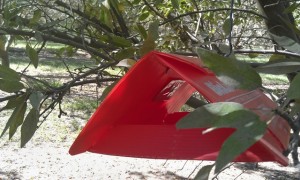New Navel Orangeworm Pheromone Lure Shows Promising Results

Delta trap in almond orchard with NOW BioLure adhered inside.
Photo by Chuck Burks, USDA-ARS
A new navel orangeworm (NOW) lure could help almond, pistachio and walnut growers better monitor their orchards for this devastating pest.
Chuck Burks, a USDA Agricultural Research Service entomologist in California, is studying the BioLure to determine how it can best be used to reduce insecticide use and maximize yields.
The BioLure, available from Suterra and through ag chemical distributors, is the first NOW lure that uses pheromones. “This is a big deal, because most of the other major pests had already had a pheromone lure, but the navel orangeworm proved to be rather difficult, I think because of the complexity of the pheromone blend and the fact that major components were not, by themselves, attractive,” Burks explains.
The NOW pheromone lure was first released in 2013, and Burks is now looking at best practices to help growers maximize the lure’s results, including examining how the lure interacts with trap types and the ideal number of traps to use for optimum results.
In the past, growers have used traps supplied with almond meal to attract NOW. They would then have to count eggs left in those traps – a labor-intensive and often unreliable method. The new NOW BioLure uses a synthesized pheromone blend to attract males and can be used various types of traps. With this lure, growers only have to count the captured males, not the eggs.
Studies have shown that the BioLure is more effective in wing traps than in bucket or delta traps. However, the easier-to-use delta trap still did capture a significant number of insects, making it effective as well.
Growers are funding the current research, and Burks is working closely with Wonderful Orchards’ Brad Higbee, who directs a team of technicians and researchers who conduct applied and basic research in IPM, population dynamics, surveillance, biological control, chemical ecology, biology management and control of nut pests.
Higbee says the BioLure has a much larger range of attractiveness than previous lures that attracted females. “The pheromone lure has much greater sensitivity or resolution in characterizing moth activity, particularly in lower populations in almonds and importantly in pistachio orchards after June, a period when almond or pistachio meals are not particularly attractive to NOW,” Higbee says. “Due to its greater sensitivity and consistent attractiveness throughout the year, the BioLure has been a tremendous help in characterizing population dynamics and, with other tactics, predicting risk from NOW damage.”
More information is available in the USDA ARS AgResearch Magazine.










